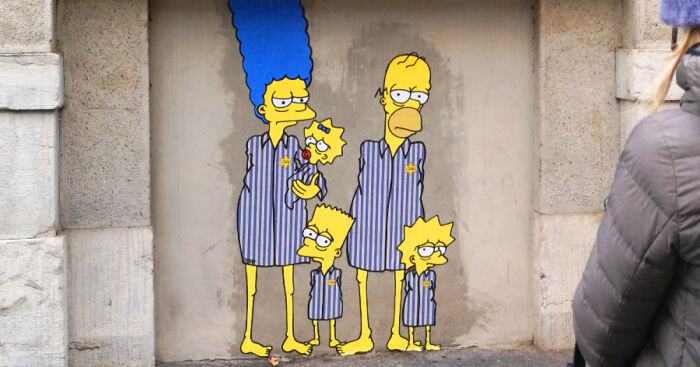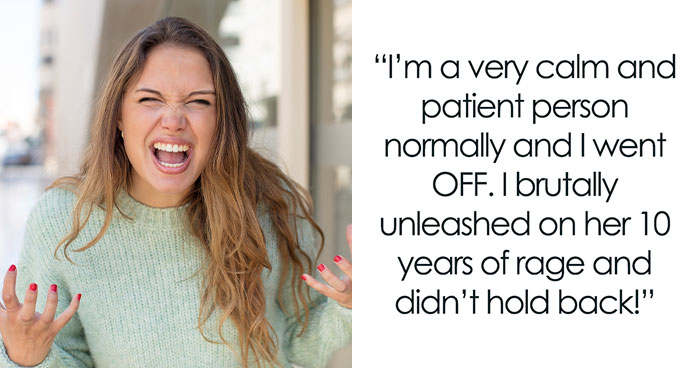
This Artist Paints ‘Simpsons’ Characters As Holocaust Victims Outside The Milan Shoah Memorial
“Track 21 The Simpsons deported to Auschwitz” the new murals by artist aleXsandro Palombo appeared on the walls of the Shoah Memorial at Milan’s central station (Binario 21) on the occasion of Holocaust Remembrance Day. The artist portrays the Simpson family deported to Nazi concentration camps and creates two symbolic murals that tell the story before and after the deportation.
“We appreciate the intention behind it, and don’t find it particularly harmful,” said Roberto Jarach, president of the foundation, to the JTA (Jewish Telegraphic Agency).
From “Track 21” of Milan’s central station, hundreds of Jews were loaded onto livestock wagons headed for the concentration camps of Auschwitz-Birkenau, Mauthausen, Bergen-Belsen, Flossenbürg, Ravensbrück, Fossoli, and Bolzano. Milan Track 21 is the hidden gateway to hell for Jews in the days of World War II. Today it is converted into a memorial for the world to know.
More info: Instagram
Image credits: alexsandropalombo
The first artwork is a portrait of the family before the deportation, in the second one the Simpsons, now prisoners, appear emaciated, skeletal, and wearing the striped uniforms of the concentration camps, deprived of their dignity. A reflection on the absolute evil that was Nazism, a warning to cherish the memory and not allow time for it to fall into oblivion.
To remember the holocaust and stigmatize evil, the artist uses his well-known neo-pop language famous for the use of cartoons, and always close to the sensitivity of young people. “These works are a visual stumble that allows us to see what we no longer see. The most terrible things can become reality and Art has the duty to remember them because it is a powerful antidote against oblivion. The horror of the Jewish genocide must be transmitted without filters to the new generations to protect humanity from other horrors such as the Shoah” declared aleXsandro Palombo.
Palombo’s works are famous all over the world for the reflective, colorful, and irreverent style that draws inspiration from pop culture and for the use of cartoons.
This is not the first time that the artist tackles the theme of the Holocaust, his works on the Holocaust have been published and analyzed in important international essays including “Holocaust Icons in Art: The Warsaw Ghetto Boy and Anne Frank” written by the authoritative Israeli historian Batya Brutin, art critic and visual arts researcher of the Holocaust in Israel and in the world, winner of the Yad Vashem award for lifetime achievement in the field of Holocaust education.
Image credits: alexsandropalombo
Image credits: alexsandropalombo
Image credits: alexsandropalombo
Image credits: alexsandropalombo
Image credits: alexsandropalombo
Image credits: alexsandropalombo
Image credits: alexsandropalombo
599views
Share on FacebookExplore more of these tags
Ok. I guess I can see the artist's concept here. Although the Simpson family doesn't look all that different in the two pictures. More realistically, Marge would have all her hair shaven off, the males and females would be separated from each other (probably never to see each other again), and the baby would have been killed right away (because she couldn't do any labor). That was the reality for the families that got off the trains at Auschwitz.
Ok. I guess I can see the artist's concept here. Although the Simpson family doesn't look all that different in the two pictures. More realistically, Marge would have all her hair shaven off, the males and females would be separated from each other (probably never to see each other again), and the baby would have been killed right away (because she couldn't do any labor). That was the reality for the families that got off the trains at Auschwitz.

 Dark Mode
Dark Mode 

 No fees, cancel anytime
No fees, cancel anytime 

























































6
4